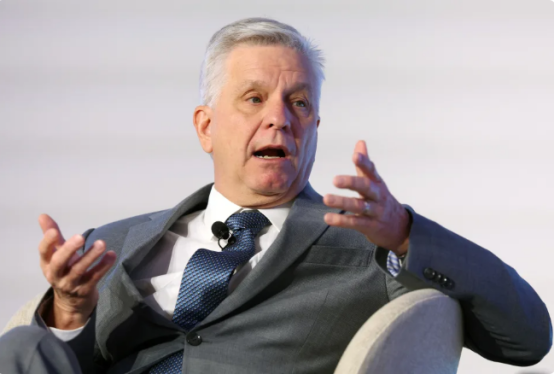
Updated Tue, June 3, 2025
A divide is emerging within the Federal Reserve about whether to hold rates steady for some time or get more comfortable about cuts later this year as officials try to determine whether any inflation coming from President Trump's tariffs will prove to be longer-lasting.
Some policymakers are arguing for "looking through" the impact of the duties as temporary, a stance that would leave the door open for cuts. Many on the rate-setting committee, however, believe there is a risk that inflation from tariffs could become more persistent.
Federal Reserve governor Chris Waller is now firmly in the first camp. On Sunday night, he made another argument for why any impact on inflation from tariffs likely won't last.
"Given my belief that any tariff-induced inflation will not be persistent and that inflation expectations are anchored, I support looking through any tariff effects on near-term inflation when setting the policy rate," Waller said in a speech in Seoul, South Korea.
This aligns with the White House's view that any price increases will be transitory. Trump himself has repeatedly called for the Fed and Chair Jerome Powell to lower rates.
Waller stressed that a strong job market and progress on inflation through April offer additional time to see how trade negotiations play out and the economy evolves.
But he does see a scenario in which he would support "good news" rate cuts later this year if inflation continues to make progress toward the Fed's 2% goal, the job market remains solid, and the effective tariff rate settles close to his new outlook of 15%.

Federal Reserve governor Christopher Waller.
Chicago Fed president Austan Goolsbee also said Monday that uncertainty around tariffs is creating what he called some "dirt in the air," but “I still think underneath there we basically are on that path" for lower rates.
"If we can get past this bumpy period that the dual mandate still looks pretty good to me,” he added.
But other members of the Fed — including Minneapolis Fed president Neel Kashkari and Dallas Fed president Lorie Logan — have been more vocal about holding rates steady.
Kashkari said last week that he believes trade talks could take months or years to resolve and that tariff increases could occur tit for tat as trading partners respond to one another.
Thus, he wants to hold rates steady "until there is more clarity on the path for tariffs and their impact on prices."
"I find these arguments more compelling given the paramount importance I place on defending long-run inflation expectations," he added.
Logan sent a strong veiled message last week about holding rates steady in the face of Trump's calls to lower them.
She said rates are in a "good place" now and that it could take "quite some time to know whether the balance of risks is shifting in one direction or another."
She added that the effects of rate changes take time to play out, and to get the balance right, the Fed needs to think about where the economy is headed, not just where it is now.
"In the short run, a central bank could always juice employment by cutting interest rates," Logan said. "People might enjoy that for a little while. But over time, excessive rate cuts would trigger a spiral of inflation."
She reiterated Monday in Dallas that there are risks to both side of the Fed's mandate for stable prices and full employment and that "monetary policy is really well positioned for us to wait and be patient and watch the data knowing that if the risks are to materially change on either side, we're well positioned to act."

Lorie Logan, president and CEO of the Federal Reserve Bank of Dallas.
According to the Fed minutes from the central bank's May policy meeting released last week, some officials thought tariffs on intermediate goods — parts used to make products, like steel or aluminum — could contribute to a more persistent increase in inflation.
And Trump announced on Friday that he will double tariffs on steel and aluminum imports to 50% from 25%.
A few officials at the last meeting thought supply chain disruptions caused by tariffs could also have longer-lasting effects on inflation, reminiscent of such effects during the pandemic.
But several said a number of factors could offset the uptick and persistence in inflation, including reductions in tariff increases through trade negotiations, consumers' low appetite for price increases, the potential for a weakening economy, or if firms move to increase market share rather than raise prices.
Waller said Sunday that he expects the effects on inflation to be temporary and most apparent in the second half of 2025. He noted that it will hinge on the ultimate size of the increase and on how exporters and importers respond.
Waller thinks any inflation from tariffs will prove fleeting because there is no shortage of workers as there was during the pandemic, there's no indication right now that tariffs are causing big disruptions in supply chains, and there's no giant government stimulus as there was during COVID.
He noted that there was very little evidence of trade policies' effects on inflation or the economy through April, but that may change in the coming weeks.
"As of today, I see downside risks to economic activity and employment and upside risks to inflation in the second half of 2025, but how these risks evolve is strongly tied to how trade policy evolves," Waller said.